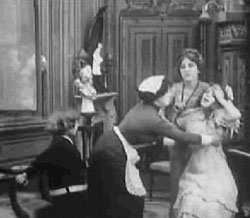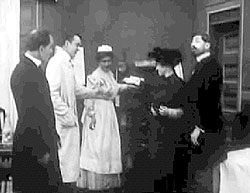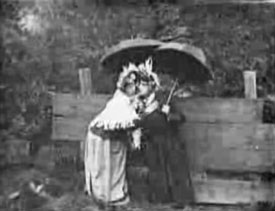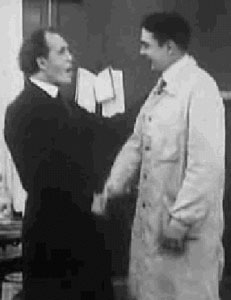 In the eleven-minute silent Falling Leaves (1912), by a woman pioneer of early cinema, Dr. Headley has devised a cure for consumption, & is giving a presentation of his process to investors or fellow physicians.
In the eleven-minute silent Falling Leaves (1912), by a woman pioneer of early cinema, Dr. Headley has devised a cure for consumption, & is giving a presentation of his process to investors or fellow physicians.
A gaunt pasty-faced gent & other cured patients come forth to prove their lungs are now cleared.
That autumn, not far away from the doctor's clinic, young Winifred is very ill with the disease, cared for by her worried family.
The family doctor has given up. Looking out into the autumn garden, he says, "When the last leaf has fallen, she will die."
 Trixie, Winifred's baby sister, secretly plans to save her big sister's life. Trixie, Winifred's baby sister, secretly plans to save her big sister's life.
She sneaks into the garden at dusk, still in her nightclothes, & with string ties leaves firmly to the branches.
This part of the tale closely resembles "The Last Leaf" by O. Henry, a key influence for the film, O Henry having been the single most widely read short story writer of the era.
Dr. Headley is strolling by & is curious about this activity. Upon hearing Trixie's explanation, he realizes his new "wonderful serum" is needed. He treats Winifred by innoculation &smp she slowly recovers, completing the simple melodrama.
This little melodrama was the work of a woman pioneer of early cinema. Alice Guy directed her first film fiction in 1896, her last in 1920. See also my review of Alice Guy's gay western Algie the Miner (1912).
A bit over a minute length, Women's Rights; aka, Ladies Skirts Nailed to Fence (1899) is not about women's rights at all. Rather, it is a comedy played by two overdressed transvestites, each with a large umbrella.
They stand against a wooden fence in a garden. Biddies by a "fence" in silent cinema & in newspaper cartoons always implied gossips. The two "ladies" get very antic, hugging one another, whispering into one another's ears.
They then unexpectedly teleport to the opposite side of the wooden fence. This is actually supposed to look like the camera-eye-view changed to the other side of the fence. But because it was difficult to move stationary cameras of the era once they were set up, we're still watching the same side of the fence, as the the position of the slats on the outerside of the fence posts makes all too obvious.
 This strange fake jump-cut was, however, the first time in youthful cinema that a second camera angle from another location was even faked, & it will be faked a second time in this stationary three-shot film. This strange fake jump-cut was, however, the first time in youthful cinema that a second camera angle from another location was even faked, & it will be faked a second time in this stationary three-shot film.
Now that the biddies are (supposedly) on the other side of the fence, a boy or a young man is able to sneak into the scene, kneeling unseen against the fence to listen to the gossiplping old gals.
Soon a second lad arrives in a crouch, & they pull the hems of the biddies' garments through cracks in the slat fence, nailing them to the boards. The biddies reach over the fence with their umbrellas batting the boys to make them leave.
Again unexpectedly, they teleport back to the front of the fence, thouigh still nailed to fence. They flail about until the board comes loose from the fence posts, & off they go dragging the board. This film has been circulated on the dvd Early Cinema: Primitives & Pioneers (2005).
A set of cards was produced by James Bamford showing scenes from this film, but entitled "Gossips & Evesdroppers." As the cards include text, a bit more of a story is revealed, such as is not evident from the film itself. The card text though calling the biddies "gossips" states that they were actually talking about women's rights. So the young men nailed them to the fence because that's what suggragettes deserved.
copyright © by Paghat the Ratgirl
|

